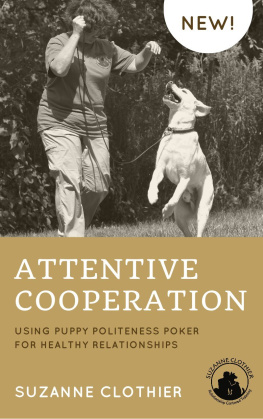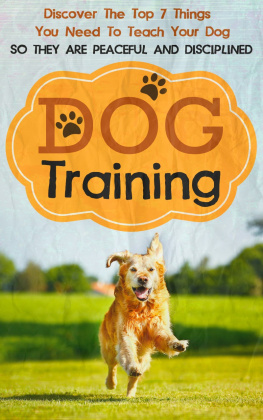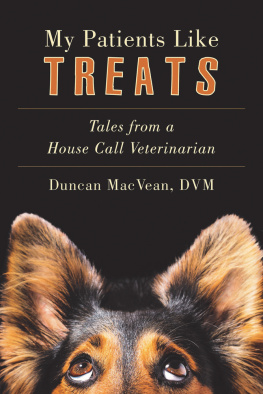C opyright 1996 , 2017 by Suzanne Clothier.
All rights reserved.
N o part of this booklet may be reproduced in any manner without written permission from the author & publisher.
S ome or all of this material originally appeared as part of the Camp Dances With Dogs workbook.
P.O. Box 105
St. Johnsville NY 13452
T he Seven Cs
A s I drove home through the dark night, he reached out to hold my hand with gentle pressure, pressing his body against mine, his breathing soft and regular as he dozed, tired from the hours we had spent on the mountain searching for a lost boy. The occasional passing truck momentarily lighted his fur, outlining briefly this young German Shepherd who was my partner in Search and Rescue.
When I whispered to him how very proud I was of him, his toes tightened slightly on my hand, acknowledging my comment though he did not stir. At that moment, cold and wet and tired, peering through the fog to the road that led home, I felt deeply the powerful connection between myself and Chilkat, and the wonder of an exceptional relationship with an exceptional dog.
I though about the dogs that had come before Chilkat, and all that they had taught me, and all the mistakes I had made. Arrogant, selfish, demanding, unfair, even cruel at times in such a stumbling fashion I have moved through my years and relationships with dogs, searching for the methods, attitudes, understanding and self-knowledge that would light the way to just this moment where a dog reached out a paw to hold my hand as he slept. To this moment where Chilkat and I met, however briefly, in a place where perfect understanding existed between us, leaving him superbly canine and me fully human. I have been blessed with many such moments with many dogs.

A s a professional trainer , it is my job to help dogs and their people build or repair relationships. I have learned the theories and principles of operant conditioning, canine behavior, movement, structure, psychology, developmental periods on and on across my shelves the books march, each contributing to my intellectual knowledge, a few touching my heart.
It is possible to say that I have learned much technical information indeed, I can play the jargon game. And yet, what I have learned that matters most to the dogs and people I encounter, and what I value most for myself, is simply this what the dogs themselves have taught me when I was quiet enough to believe what the dogs told me was true for them, despite prevailing wisdom or theories.

A relationship with another being is a complex thing. At times, when all is going well, a relationship sustains us, cheers us, warms us in the unconditional acceptance of who we are, and in the willing and joyful compliance of each to the other for mutual delight. It is easy indeed to be a fair weather friend, but the watermark of an individual is their ability to withstand the darker days, the misunderstandings, the lack of mutuality of desires, their willingness to analyze, understand and accept their contribution to the estrangement, and their degree of self-knowledge and therefore capacity for change, and thus a different, deeper relationship with another.
Unless a dog is simply a means to an end for you, a tool to be used as needed for achievement of a goal, it is the relationship with a dog that drives you to learn more. All of us have had glorious moments with our dogs, moments that give shape and meaning to the connection that exists between us and these dogs.
Recognizing these moments as not only possible but powerfully good, we seek out new ways to enrich this relationship so that over and over again, we can find that moment where everything hangs in a perfect balance of human and canine.
H ere are seven key points that mark all successful relationships, especially the relationship the exists between a dog and owner:
Communication
Clarity
Creativity
Confidence
Congruity
Consistency
Condition
When all seven exist in harmony, the dance can truly begin. To the extent that one or more points are out of balance, the relationship and the effectiveness of the handler/dog team will suffer. In my experience, the joy of being with and working with a dog in any capacity is lost when we lose the harmony within ourselves and thus within the relationship. By acting as reflections of how well we a have found balance within ourselves, our dogs serve us well as our best teachers, provided we are willing to learn from them.
When evaluating a training problem, a behavior problem or a kink in a relationship, you will often discover one or more of these basic concepts either missing or not balanced between dog and handler. Be leery of reductionist approaches that pinpoint one area and attempt to fix that the training process is much like a chain of chemical reactions. Alter the chemical makeup of just one component and you will affect the chemistry of all others.
The human tendency to position ourselves as superior to the dog can present problems when we place blame or excessive responsibility for our half of the relationship.
Notice that the emphasis repeatedly is on the interaction between dog and handler, not just the dog. This is a two-way street! Handlers fail their dogs far more often than dogs ever fail their handlers. Wise trainers know this, apologize for their own shortcomings and are grateful for the good grace with which dogs accommodate their handlers. In search of the harmony between one being and another there lies a wonderful journey.















